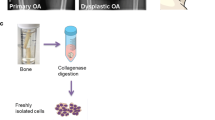Abstract.
Bone loss with aging may be due, at least in part, to inadequate bone formation. Moreover, the process of bone aging is known to follow a different pattern throughout the skeleton. In this study, we examined the cell proliferation rate (area under the cell growth curve, AUC) and the secretion of C-terminal type I procollagen (PICP), alkaline phosphatase (ALP), and osteocalcin (OC) in primary cultures of osteoblastic cells from human trabecular bone. Osteoblastic cells were obtained for 168 donors (100 women and 68 men). Ninety-eight bone samples were obtained from subjects undergoing knee arthroplastia, 52 aged 50–70 years (64 ± 5) and 46 over age 70 (73 ± 2). Another 70 bone samples were obtained from subjects undergoing hip arthroplastia; 51 were 50–70 years old (64 ± 4) and 19 were over 70 (75 ± 5). Osteoblastic cells from the older donors had a lower proliferation rate and OC secretion than those from younger subjects. However, ALP secretion was higher in the former subjects, whereas PICP secretion was unchanged. Osteoblastic cells from hip had a lower proliferation rate than those from knee. PICP secretion was also lower and ALP secretion was higher in the former cells. In age-matched cell cultures, osteoblastic cells from the knee had higher proliferation rate and PICP secretion than osteoblastic cells from the hip. However, ALP secretion was lower in knee osteoblastic cells than those from hip only in the younger group. With aging, ALP secretion was found to increase in knee osteoblactic cells, whereas OC secretion decreased in osteoblastic cell cultures from the hip. Our findings suggest that bone loss with aging may be accounted for, at least in part, by a decreased osteoblastic cell proliferation and an increased osteoblastic maturation. In addition, our data indicate that these changes with aging do not occur similarly at different skeletal sites.
Similar content being viewed by others
Author information
Authors and Affiliations
Additional information
Received: 25 March 1998 / Accepted: 1 October 1998
Rights and permissions
About this article
Cite this article
Martínez, M., del Campo, M., Medina, S. et al. Influence of Skeletal Site of Origin and Donor Age on Osteoblastic Cell Growth and Differentiation. Calcif Tissue Int 64, 280–286 (1999). https://doi.org/10.1007/s002239900619
Issue Date:
DOI: https://doi.org/10.1007/s002239900619




